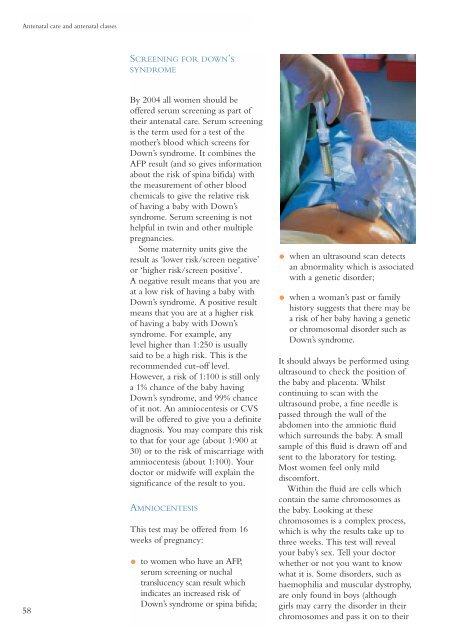here - Health Promotion Agency
here - Health Promotion Agency
here - Health Promotion Agency
Create successful ePaper yourself
Turn your PDF publications into a flip-book with our unique Google optimized e-Paper software.
Antenatal care and antenatal classes<br />
SCREENING FOR DOWN’S<br />
SYNDROME<br />
58<br />
By 2004 all women should be<br />
offered serum screening as part of<br />
their antenatal care. Serum screening<br />
is the term used for a test of the<br />
mother’s blood which screens for<br />
Down’s syndrome. It combines the<br />
AFP result (and so gives information<br />
about the risk of spina bifida) with<br />
the measurement of other blood<br />
chemicals to give the relative risk<br />
of having a baby with Down’s<br />
syndrome. Serum screening is not<br />
helpful in twin and other multiple<br />
pregnancies.<br />
Some maternity units give the<br />
result as ‘lower risk/screen negative’<br />
or ‘higher risk/screen positive’.<br />
A negative result means that you are<br />
at a low risk of having a baby with<br />
Down’s syndrome. A positive result<br />
means that you are at a higher risk<br />
of having a baby with Down’s<br />
syndrome. For example, any<br />
level higher than 1:250 is usually<br />
said to be a high risk. This is the<br />
recommended cut-off level.<br />
However, a risk of 1:100 is still only<br />
a 1% chance of the baby having<br />
Down’s syndrome, and 99% chance<br />
of it not. An amniocentesis or CVS<br />
will be offered to give you a definite<br />
diagnosis. You may compare this risk<br />
to that for your age (about 1:900 at<br />
30) or to the risk of miscarriage with<br />
amniocentesis (about 1:100). Your<br />
doctor or midwife will explain the<br />
significance of the result to you.<br />
AMNIOCENTESIS<br />
This test may be offered from 16<br />
weeks of pregnancy:<br />
• to women who have an AFP,<br />
serum screening or nuchal<br />
translucency scan result which<br />
indicates an increased risk of<br />
Down’s syndrome or spina bifida;<br />
• when an ultrasound scan detects<br />
an abnormality which is associated<br />
with a genetic disorder;<br />
•<br />
when a woman’s past or family<br />
history suggests that t<strong>here</strong> may be<br />
a risk of her baby having a genetic<br />
or chromosomal disorder such as<br />
Down’s syndrome.<br />
It should always be performed using<br />
ultrasound to check the position of<br />
the baby and placenta. Whilst<br />
continuing to scan with the<br />
ultrasound probe, a fine needle is<br />
passed through the wall of the<br />
abdomen into the amniotic fluid<br />
which surrounds the baby. A small<br />
sample of this fluid is drawn off and<br />
sent to the laboratory for testing.<br />
Most women feel only mild<br />
discomfort.<br />
Within the fluid are cells which<br />
contain the same chromosomes as<br />
the baby. Looking at these<br />
chromosomes is a complex process,<br />
which is why the results take up to<br />
three weeks. This test will reveal<br />
your baby’s sex. Tell your doctor<br />
whether or not you want to know<br />
what it is. Some disorders, such as<br />
haemophilia and muscular dystrophy,<br />
are only found in boys (although<br />
girls may carry the disorder in their<br />
chromosomes and pass it on to their
















